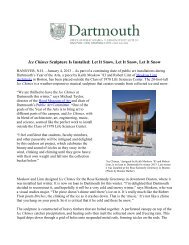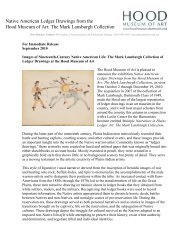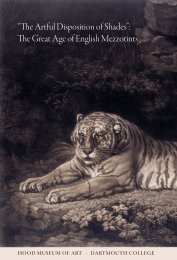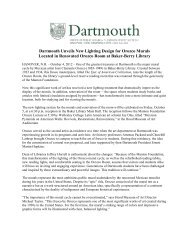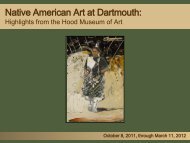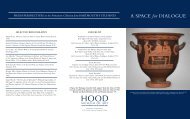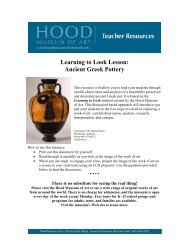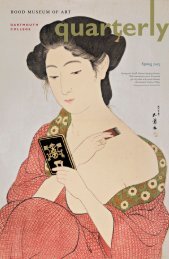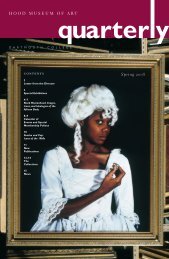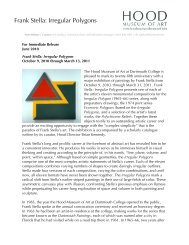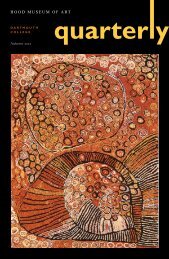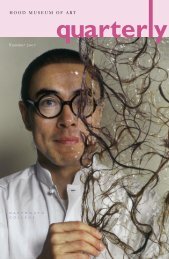Frank Stella: Irregular Polygons - Hood Museum of Art - Dartmouth ...
Frank Stella: Irregular Polygons - Hood Museum of Art - Dartmouth ...
Frank Stella: Irregular Polygons - Hood Museum of Art - Dartmouth ...
Create successful ePaper yourself
Turn your PDF publications into a flip-book with our unique Google optimized e-Paper software.
<strong>Frank</strong> <strong>Stella</strong>: <strong>Irregular</strong> <strong>Polygons</strong><br />
News Release | Contact: Nils Nadeau, Communications and Publications Manager | (603) 646-2095 | nils.nadeau@dartmouth.edu<br />
<br />
<br />
For Immediate Release<br />
June 2010<br />
<br />
<strong>Frank</strong> <strong>Stella</strong>: <strong>Irregular</strong> <strong>Polygons</strong><br />
October 9, 2010 through March 13, 2011<br />
The <strong>Hood</strong> <strong>Museum</strong> <strong>of</strong> <strong>Art</strong> at <strong>Dartmouth</strong> College is<br />
pleased to announce a major exhibition <strong>of</strong><br />
paintings by <strong>Frank</strong> <strong>Stella</strong> from October 9, 2010,<br />
through March 31, 2011. To mark the twenty-fifth<br />
anniversary <strong>of</strong> the <strong>Hood</strong> <strong>Museum</strong> <strong>of</strong> <strong>Art</strong>, <strong>Frank</strong><br />
<strong>Stella</strong>: <strong>Irregular</strong> <strong>Polygons</strong> presents one <strong>of</strong> each <strong>of</strong><br />
the artist’s eleven monumental compositions for the<br />
<strong>Irregular</strong> Polygon (1965–66) series, along with<br />
preparatory drawings, the 1974 print series<br />
Eccentric <strong>Polygons</strong> (based on the <strong>Irregular</strong><br />
<strong>Polygons</strong>), and a selection <strong>of</strong> his latest works, the<br />
Polychrome Reliefs. Together these objects testify to<br />
an outstanding artistic career and provide an exciting opportunity to engage with the<br />
“complex simplicity” that is the paradox <strong>of</strong> <strong>Frank</strong> <strong>Stella</strong>’s art. The exhibition is<br />
accompanied by a scholarly catalogue written by its curator, <strong>Hood</strong> Director Brian<br />
Kennedy.<br />
<strong>Frank</strong> <strong>Stella</strong>’s long and prolific career at the forefront <strong>of</strong> abstract art has revealed him to be<br />
a consistent innovator. He produces his works in series as he immerses himself in visual<br />
thinking and creating according to the principle <strong>of</strong>, in his words, “line, plane, volume, and<br />
point, within space.” Although based on simple geometries, the <strong>Irregular</strong> <strong>Polygons</strong><br />
comprise one <strong>of</strong> the most complex artistic statements <strong>of</strong> <strong>Stella</strong>’s career. Each <strong>of</strong> the eleven<br />
compositions combines varying numbers <strong>of</strong> shapes to create daringly irregular outlines.<br />
<strong>Stella</strong> made four versions <strong>of</strong> each composition, varying the color combinations, and until<br />
now, all eleven formats have never been shown together. The <strong>Irregular</strong> <strong>Polygons</strong> mark a<br />
radical shift from <strong>Stella</strong>’s earlier striped paintings in their use <strong>of</strong> large fields <strong>of</strong> color. These<br />
asymmetric canvases play with illusion, confronting <strong>Stella</strong>’s previous emphasis on flatness<br />
while perpetuating his career-long exploration <strong>of</strong> space and volume in both painting and<br />
sculpture.<br />
In 1985, the year the <strong>Hood</strong> <strong>Museum</strong> <strong>of</strong> <strong>Art</strong> at <strong>Dartmouth</strong> College opened to the public,<br />
<strong>Frank</strong> <strong>Stella</strong> spoke at the annual convocation ceremony and received an honorary degree.<br />
In 1963 he had been an artist-in-residence at the college, making works for the series that<br />
became known as the <strong>Dartmouth</strong> Paintings, each <strong>of</strong> which was named after a city in
<strong>Frank</strong> <strong>Stella</strong>: <strong>Irregular</strong> <strong>Polygons</strong><br />
News Release | Contact: Nils Nadeau, Communications and Publications Manager | (603) 646-2095 | nils.nadeau@dartmouth.edu<br />
<br />
<br />
Florida that he had visited while on a road trip there in 1961. In 1965–66, two years after<br />
he left the <strong>Dartmouth</strong> campus, he named each <strong>of</strong> the eleven compositions <strong>of</strong> his <strong>Irregular</strong><br />
<strong>Polygons</strong> series after small towns in New Hampshire—Chocorua, Conway, Effingham,<br />
Moultonboro, Moultonville, Ossipee, Sanbornville, Sunapee, Tuftonboro, Union, and<br />
Wolfeboro. During his boyhood, his father had brought him to a family camp near<br />
Ossipee for fishing trips in New Hampshire’s mountains, lakes, and rivers. <strong>Stella</strong> is<br />
delighted to have the opportunity to return to <strong>Dartmouth</strong> College as a Montgomery Fellow<br />
from October 17 to October 24, 2010. On Thursday, October 21, at 4:30 p.m., he will<br />
participate in a question-and-answer session in <strong>Dartmouth</strong>’s Spaulding Auditorium. This<br />
event is free and open to the public.<br />
About <strong>Frank</strong> <strong>Stella</strong><br />
When presenting <strong>Frank</strong> <strong>Stella</strong> with the National Medal <strong>of</strong> the <strong>Art</strong>s on February 25, 2010,<br />
President Barack Obama described him as “obviously a legend for his accomplishments as<br />
one <strong>of</strong> the world’s most innovative painters and sculptors. His sophisticated visual<br />
experiments—<strong>of</strong>ten transcending boundaries between painting, print making, and<br />
sculpture—are modern masterpieces.”<br />
<strong>Frank</strong> <strong>Stella</strong> burst on the New York art scene in 1958, when some <strong>of</strong> his “black paintings”<br />
were included in the exhibition Sixteen Americans at the <strong>Museum</strong> <strong>of</strong> Modern <strong>Art</strong>. Since<br />
then he has made an extraordinary contribution to the visual arts, consistently<br />
investigating pictorial ideas according to key artistic principles: “Line, plane, volume, and<br />
point, within space.” <strong>Stella</strong> was born in 1936 and attended Phillips Academy, Andover,<br />
and Princeton University, from which he graduated in 1958. He has lived in New York<br />
ever since. His consistent inventiveness has seen him make remarkable advances in<br />
pictorial and sculptural tradition.<br />
In 1963, <strong>Stella</strong> was an artist-in-residence at <strong>Dartmouth</strong> College. By that time, he was<br />
making his powerfully influential shaped paintings, which he launched with his aluminum<br />
paintings (1960), and then pursued further with the irregularly shaped paintings known as<br />
the <strong>Irregular</strong> <strong>Polygons</strong> (1965–66). From the 1970s onward, <strong>Stella</strong> has explored the arts <strong>of</strong><br />
sculpture and print making; he continues to work assiduously today, and his art can be<br />
seen in nearly all <strong>of</strong> the world’s major museums. At the age <strong>of</strong> seventy-four, he is without<br />
doubt one <strong>of</strong> the most significant artists <strong>of</strong> the last half century to work in the abstract<br />
tradition <strong>of</strong> painting, sculpture, and print making.<br />
<strong>Frank</strong> <strong>Stella</strong>: <strong>Irregular</strong> <strong>Polygons</strong><br />
News Release | Contact: Nils Nadeau, Communications and Publications Manager | (603) 646-2095 | nils.nadeau@dartmouth.edu<br />
<br />
<br />
<br />
About the <strong>Hood</strong> <strong>Museum</strong> <strong>of</strong> <strong>Art</strong><br />
The <strong>Hood</strong> <strong>Museum</strong> <strong>of</strong> <strong>Art</strong> is dedicated to teaching and promoting visual literacy for all <strong>of</strong><br />
its visitors. This dynamic educational and cultural facility houses one <strong>of</strong> the oldest and<br />
largest college collections in the country, with more than 65,000 objects acquired since<br />
1772. Among its most important works are six Assyrian stone reliefs that date from around<br />
900 BCE. The collection also presents art from other ancient cultures, the Americas,<br />
Europe, Africa, Papua New Guinea, and many more regions <strong>of</strong> the world. The <strong>Hood</strong> seeks<br />
to inspire and educate through direct engagement with works <strong>of</strong> art and <strong>of</strong>fers access to<br />
the rich diversity <strong>of</strong> its collections through ongoing highlights displays, special exhibitions,<br />
an online collections database, and a wide array <strong>of</strong> programs and events.<br />
Additional images available upon request.<br />
Image credit: <strong>Frank</strong> <strong>Stella</strong>, Chocorua IV, 1966, fluorescent alkyd and epoxy paints on canvas, 120 x 128 x 4<br />
in. (304.8 x 325.12 x 10.16 cm). <strong>Hood</strong> <strong>Museum</strong> <strong>of</strong> <strong>Art</strong>, <strong>Dartmouth</strong> College: Purchased through the Miriam<br />
and Sidney Stoneman Acquisitions Fund, a gift from Judson and Carol Bemis ’76, and gifts from the Lathrop<br />
Fellows. © 2010 <strong>Frank</strong> <strong>Stella</strong> / <strong>Art</strong>ists Rights Society (ARS), New York. Photo by Steven Sloman.



